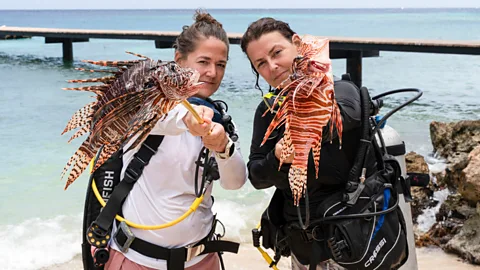Two women in Curaçao are taking on an ecological crisis, transforming the invasive lionfish from a reef-destroying predator into a sustainable food source, a tool for education, and even handcrafted jewelry.
The venomous lionfish, with its striking red, white, and brown stripes and fan-like fins, is native to the South Pacific and Indian Oceans. However, it was introduced to Florida’s Atlantic waters in the late 1980s—most likely released from marine aquariums. By the early 2000s, the species had spread to the Caribbean, including Curaçao’s coral reefs, where the local economy heavily relies on diving tourism. With no natural predators, lionfish reproduce at an alarming rate, with females laying up to two million eggs per year. They consume vast numbers of smaller native fish that protect coral reefs, reducing native reef fish populations by 79% in a short period. This disruption threatens marine biodiversity, diving tourism, and the livelihoods of those dependent on the ocean.
What began as an ecological threat has become an opportunity for innovation and conservation, thanks to two fearless women: Helmi Smeulders and Lisette Keus. Smeulders, a former lawyer from the Netherlands, moved to Curaçao in 1998 and later became a chef, diver, and advocate for sustainable fishing. Despite her culinary expertise, she knew little about lionfish hunting—until she teamed up with local diver Keus, who had already been working to control the species’ population. Keus taught Smeulders and other women on the island how to locate, catch, and clean lionfish safely. “I showed chefs how to clean them, gave them recipes, and even provided free batches of lionfish to restaurants for practice,” says Keus.
Keus had first encountered lionfish during her dives and, recognizing their impact on the reef, committed herself to controlling their numbers. She became so skilled at tracking them that she earned a reputation as a “lionfish whisperer.” In 2012, she began selling lionfish to restaurants, but at first, no one wanted to buy them. “People thought they were poisonous,” Keus recalls. “They’re actually venomous—their spines can sting, causing pain and swelling, but the meat itself is completely safe.” Despite her efforts, she often had to throw fish back into the ocean because she couldn’t sell them. To change perceptions, Keus educated chefs and restaurant owners, explaining that by preparing and serving lionfish, they were actively helping to protect Curaçao’s fragile ecosystem.
As demand grew, Keus tackled another issue—waste. Only about 20% of each lionfish was being used for food, while the spiny fins were discarded. She began collecting these discarded fins to create handcrafted jewelry, launching Lionfish Caribbean in 2016. Located in Kura Hulanda Village, her retail store sells unique jewelry made from lionfish fins and provides education and training to divers and tourists about the invasive species. She also opened a tasting room featuring lionfish tacos and fried lionfish and chips under the slogan: “We eat them to beat them.”
Smeulders, passionate about using only local ingredients, first cooked lionfish in 2013 at a prestigious dinner reception for the King and Queen of the Netherlands during their visit to Curaçao. She reached out to Keus and other divers, requesting as many lionfish as possible for the event. Then, she did what she does best—crafted a dish that combined sustainability with modern Caribbean flavors. Her poached lionfish, served with a rich hollandaise sauce and a hint of lemon, became the highlight of the meal. “Lionfish has a mild, delicate flavor—somewhere between cod and lobster,” says Smeulders. “It’s a great source of omega-3s and fits perfectly into Curaçao’s unique cuisine.”
Beyond cooking, Smeulders shares her lionfish hunting experiences with her students, using the fish as a teaching tool for sustainability and environmental responsibility. She wants people to understand the ethical importance of consuming a fish that, by being eaten, helps restore balance to the reef. She has written two cookbooks and hosts Chef’s Table events, where guests watch her and her team prepare lionfish dishes. “Some of my favorite ways to prepare lionfish are in ceviches, tartares, and tacos,” she says. “I even use the bones for stock. The spine is protein-rich, and if you heat it to 200°C for 20 minutes, it neutralizes the venom—you can use the spines as toothpicks!”
Both women admit they are addicted to the thrill of lionfish hunting. “If you wake up and realize it’s a day you get to go lionfish hunting,” Smeulders says, “then it’s definitely going to be a good day.” Through their dedication, these two fearless lionfish huntresses are not only protecting Curaçao’s coral reefs but also turning an environmental crisis into an opportunity for education, sustainability, and delicious cuisine.




